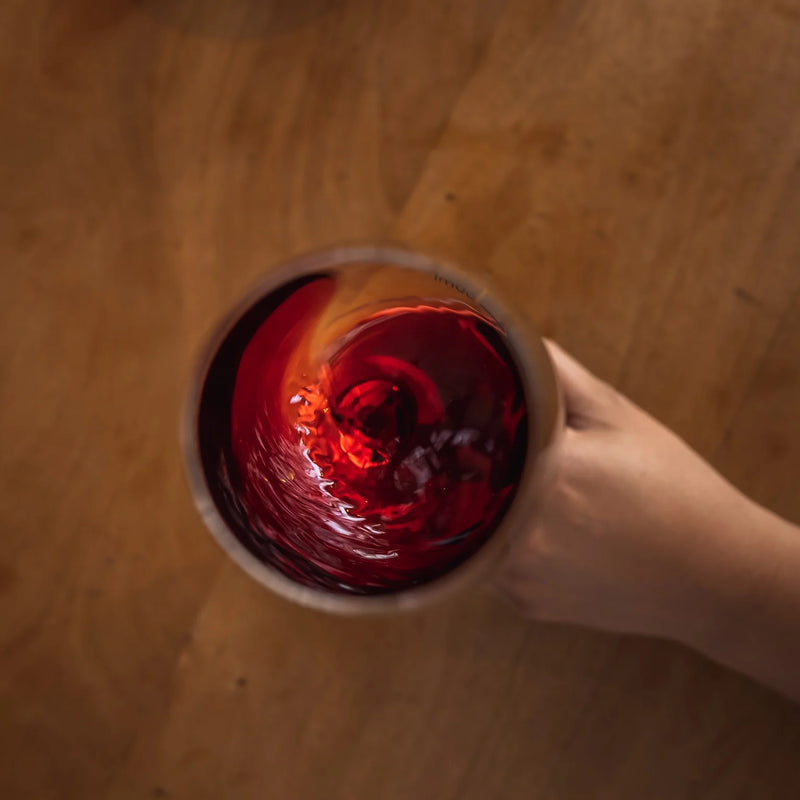
Gamay
gah-may
Origin: Beaujolais Grape: Gamay (purple-colored grape variety with thin skin) Flavors: Cherry, Raspberry, Red Currant, Cranberry, Violet, Strawberry, Banana Notable Regions: Beaujolais, Loire Valley, Niagara Peninsula, Valle d’Aoste, Willamette Valley Sweetness: Dry Body: Medium-Light Tannins: Very Low Acidity: Medium-High ABV: 10-11.5%

The History of Gamay
Gamay is an ancient varietal, with the first known written mention of the grape dating back to the 14th century. Unlike Pinot Noir, which was most popular then, Gamay was discovered to ripen two weeks earlier and was less difficult to cultivate, allowing the grape to grow in abundance. However, in 1395, Gamay was banned by the Duke of Burgundy for being “despicable and disloyal” due to the grape’s unfamiliar taste and texture. He wanted to ensure that the land would continue to be used to produce Pinot Noir, which he saw as a more respectable wine.
Even though the grape was outlawed, the southern area of Burgundy, known as Beaujolais, continued to produce Gamay for many years. The region was so successful that in the 1930s, the Institut National des Appellations d’Origine created ten areas of highly-prized terroir to cultivate the grape, located on the appellation’s best slopes.
However, in the 1950s, Beaujolais winemakers began adopting modern techniques like chaptalization, which added sugar to the wine to increase the alcohol content and used artificial yeast to expedite the fermentation process. These practices, which continued through the 1980s, significantly lessened the quality of Gamay.
In response to this excessive wine manipulation, a small group of Beaujolais winemakers decided to reclaim the ancestral, pre-technological approach to producing Gamay. Known as the “Gang of Four,” these men — Marcel Lapierre, Guy Breton, Jean Foillard, and Jean-Paul Thenevet — pushed back against the questionable practices of the region by choosing not to chaptalize or adding sulfur, a preservative, to the wine. At first, the Gang of Four was dismissed for embracing this natural approach to wine production, but over the years, they proved that the grape could yield high-quality, terroir-expressive wine.
Today, Beaujolais is home to nearly 75 percent of all Gamay vineyards worldwide. Still, the wine has been steadily growing in popularity in cool-climate regions such as Switzerland, Canada, New Zealand, and Oregon.
Insider Tip: The simplest form of Gamay is labeled as “Beaujolais” or “Beaujolais Nouveau.” For higher quality options, look for Gamay that is labeled as “Beaujolais Cru” or “Beaujolais Villages.”
Gamay Taste and Flavors

Gamay is a light-bodied red wine similar in taste to Pinot Noir but can be enjoyed at a cheaper price. With elevated acidity and little to no tannin structure, the wine is straightforward to drink and exhibits flowery aromas and tart flavors of red fruits like cherry, raspberry, cranberry, and red currant. When the carbonic maceration method is used, Gamay can also display flavors of strawberry, banana, and even bubble gum.
Carbonic Maceration
Carbonic maceration is a process of fermentation most commonly associated with Gamay, although not exclusively. Unlike the standard yeast-fueled fermentation, in which yeast is manually or naturally added to the grape to convert sugar into alcohol, carbonic maceration does not use yeast to begin fermentation. Instead, whole bunches of grapes are placed in a sealed tank filled with carbon dioxide, triggering a process within the grapes known as intracellular fermentation.
Once the alcohol level reaches about 2% ABV, the grape skins split apart and release the juice. Because carbonic maceration includes minimal contact with the grape skin, the process produces fresh-tasting wine that is lower in tannin, lighter in color, and fruity in character.
Serving and Storing Gamay
Gamay is best enjoyed when it is slightly chilled, around 54 degrees. Because most kitchen refrigerators are colder than this, it is a good idea to remove the wine well before it is served. To fully enjoy Gamay's fruity and flowery aromas, it is best served in a large, globe-shaped burgundy glass.
This will also give the wine a larger surface area, so more of the liquid can come into contact with the air. The opening of the glass is designed to direct the wine to the tip of your tongue, so you can truly savor the delicate, fruity flavors.
When storing Gamay, it is best kept between 50 and 55 degrees. If the temperature is too high, the wine will age too quickly, causing it to lose flavor and balance. On the other hand, cold temperatures will diminish the flavor and aromas. Additionally, if the temperature fluctuates too much, the cork can become damaged, which will cause the wine to spoil.
Gamay Food Pairings
Because of the wine’s high acidity and low tannin, Gamay pairs well with a wide variety of foods and is considered a “safe wine” by many sommeliers. It is light, fruity, and easy to drink, making the wine an ideal choice for parties, picnics, and even Thanksgiving dinners!
The Best Gamay Food Pairings
- Meat: Enjoy a glass of Gamay with roast chicken, chicken tagine with apricots and olives, pork sausages, duck with plum sauce, beef stroganoff, hanger steak with chimichurri, grilled steak, meatloaf, and turkey with chestnut stuffing.
- Seafood: Gamay is one of the few red wines that pair exceptionally well with seafood. Think soy-glazed salmon, grilled salmon with dijon, roasted black cod, fried calamari, cajun shrimp and grits, mussels, lobster rolls, or a crab salad.
- Cheese: When it comes to cheese, Gamay will pair nicely with brie, gruyere, Monterey Jack, cheddar, feta, and Swiss.
- Herbs and Spices: Gamay can be enjoyed with various herbs and spices, including fennel, mustard, horseradish, garlic, shallots, chives, bay leaf, leek, sage, mint, dill, nutmeg, and cinnamon.
- Vegetables: Gamay is an excellent choice for vegetable lovers. Try a glass with black olive tapenade, roasted potatoes, onion rings, roasted eggplant, portobello mushroom, spinach salad with beets, and capers.
Gamay in a Nutshell
With flowery aromas and red fruit flavors like cherry, raspberry, cranberry, and red currant, Gamay is the perfect choice for anyone who is looking for a light-bodied, fresh red wine. Because of the elevated acidity and little to no tannin structure, the wine is straightforward to drink and pairs well with all types of food — especially seafood! To fully enjoy the flavors and aromas of Gamay, it is best enjoyed slightly chilled and in a burgundy glass. If you love the taste of Pinot Noir but not the price, then Gamay is the wine for you.





